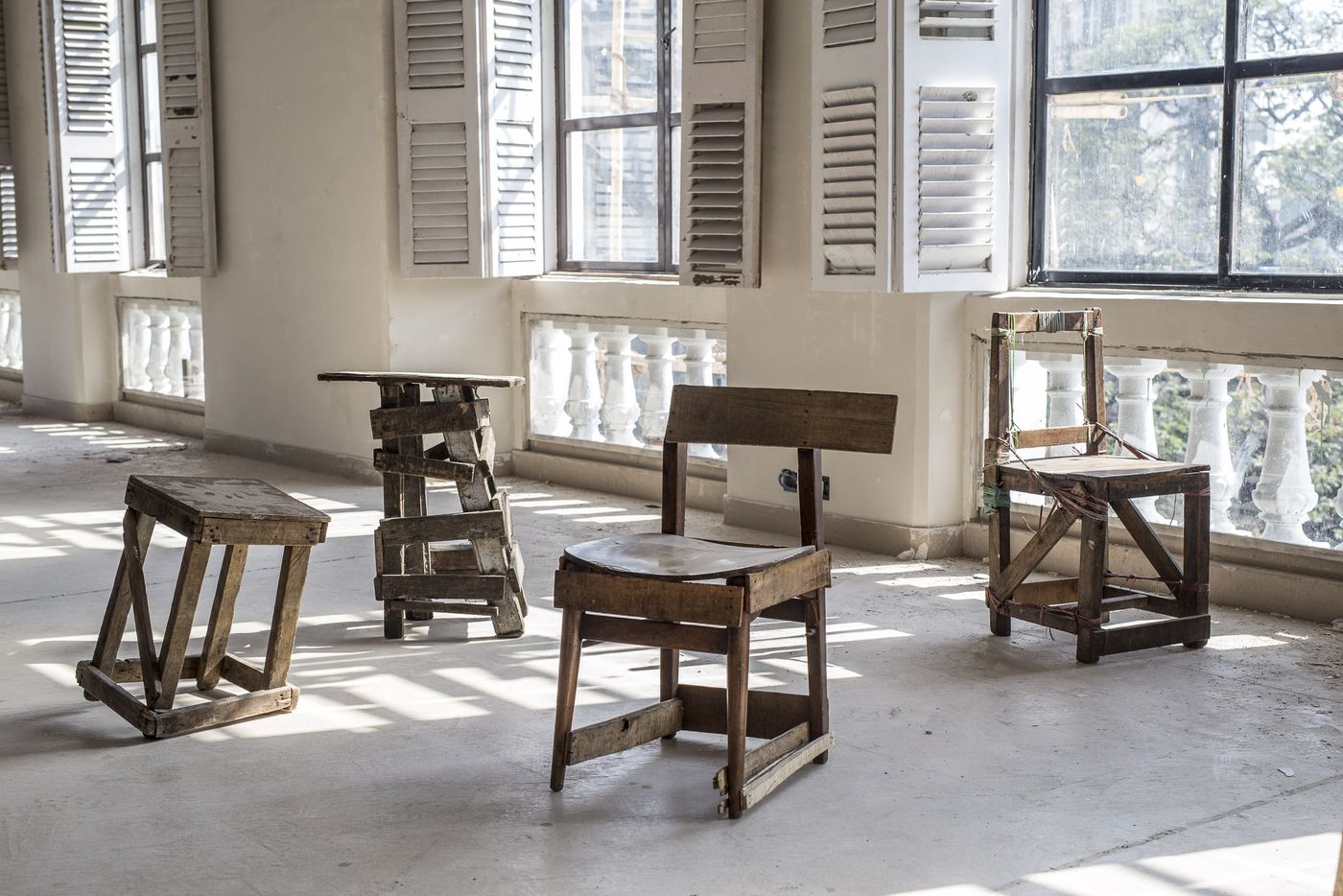Porosity Kabari
Trent Jansen, Richard Goodwin and Ishan Khosla
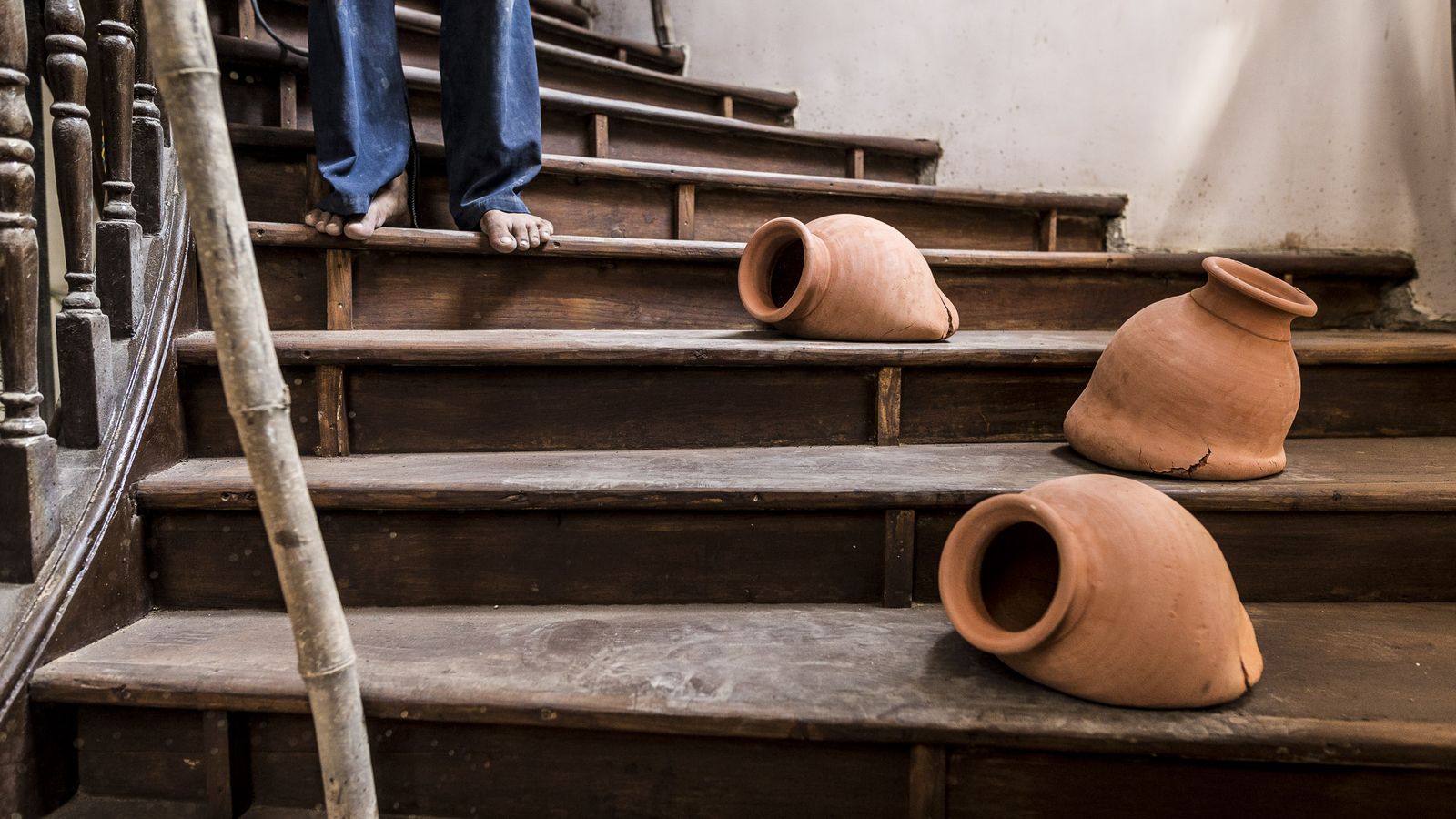
5 April – 23 May
India is a place where resourcefulness is part of the everyday. The market neighbourhoods where this project took place are where many of India’s useful objects end up. It is also where they are often given a second life – car panels are transformed into ad hoc cookers and old clothing is quilted into rugs for snake charmers.
Made from materials and craftsmanship sourced solely from the ‘Chor Bazaar’ (thieves market) and ‘Kabari Bazaars’ (junk markets) in Mumbai, India, the works in this exhibition are the result of an interdisciplinary, cross-cultural, collaborative project by Australian object designer Trent Jansen, Australian artist/architect Richard Goodwin and Indian design thinker Ishan Khosla.
The designers learnt from conversation and experimentation with the vendors and crafts people working in these manic marketplaces. The process challenged them to ‘make something from something else’ – the essence of sustainable design.
For this project, Trent Jansen explored the Indian notion of ‘jugaad’ - doing just enough with what you have on hand and figuring it out as you go. At first it made him nervous. In contrast to his usual thoroughly researched projects, this jugaad process was a free fall. It was based on observations and reactions – generating ideas by improvising forms and using only the techniques and materials that were readily available.
Goodwin’s practice as an a artist/architect, explores Duchamp’s revelation of the ‘readymade’, as fundamental to his post functionalist theory and practice. How can something be something else? His work does not invent new shapes but instead appropriates objects from differing functions, combining them at different scales to enliven and rethink design or art problems.
Ishan Khosla’s collection of furniture is made from scavenged pieces of wood sourced from found objects from the streets of Mumbai, put together in an ad hoc manner. These naive objects, which don’t follow the principles of design, are on the margins on functionality. There is a ‘typical’ aesthetic that comes out of this ‘do first think later’ action, which is related to the idea of improvisation, where time and material are scarce, as survival is at stake.
The objects produced for Porosity Kabari were made outside the industrialised system. Improvisation was the applied technique for making. Ideas were generated and design decisions were made on the fly, shaped by the daily observations and moods of the designers. The project champions the ad hoc and builds appreciation of the makeshift. It reminds us to look to and learn from those countries where, for many, resources are scarce and resourcefulness is a necessity.
Note on the name Porosity Kabari: Porosity is the ability of a membrane or material to let liquid and gases pass through it; or in this case ideas and people. Kabari is the Hindi work for junk.
Porosity Kabari was presented by Mumbai's Studio X in February 2016 and by Hotel Hotel's Nishi Gallery in June/July 2017.
Explore the exhibition room sheet here
Events:
Porosity Kabari: Trent Jansen in conversation
Australian object designer Trent Jansen discusses working in Mumbai for three weeks to create what became Porosity Kabari.
Joined on the trip by artist/architect Richard Goodwin and Indian design thinker Ishan Khosla the project challenged them to produce furniture and object pieces, made from materials and craftsmanship sourced solely from the ‘Chor Bazaar’ (thieves market) and ‘Kabari Bazaars’ (junk markets) in Mumbai, India. The process challenged them to ‘make something from something else’ – the essence of sustainable design.
Trent will discuss his experiences of working in a different way from his normal practice and how this affected the creative process.
When: Thursday 12 April 6 -8pm
Where: Australian Design Centre, 101-115 William Street, Darlinghurst
Time: 6-8pm
Free event, bookings required
Lessons in transformative objects with Professor Richard Goodwin
Richard Goodwin’s practice as an artist/architect/professor, explores Duchamp’s revelation of the ‘readymade’, as fundamental to his post functionalist theory and practice. How can something be something else? His work does not invent new shapes but instead appropriates objects from differing functions, combining them at different scales. At the city scale buildings and public spaces are transformed using these theories under his research banner - Porosity.
Goodwin will present a lecture focusing on his experiences working on this interdisciplinary, cross-cultural, collaborative project in Mumbai for three weeks alongside Australian object designer Trent Jansen and Indian design thinker Ishan Khosla to create what became Porosity Kabari.
When: Thursday 10 May, 6-8pm
Where: Australian Design Centre, 101-115 William Street, Darlinghurst
Free event, bookings required
Image:
Above: Trent Jansen, Dropping a Kumhar Wala Mudka, 2016. Photo: Neville Sukhia
Below: Ishan Khosla, Construct/Deconstruct/Construct, 2016. Photo: Neville Sukhia
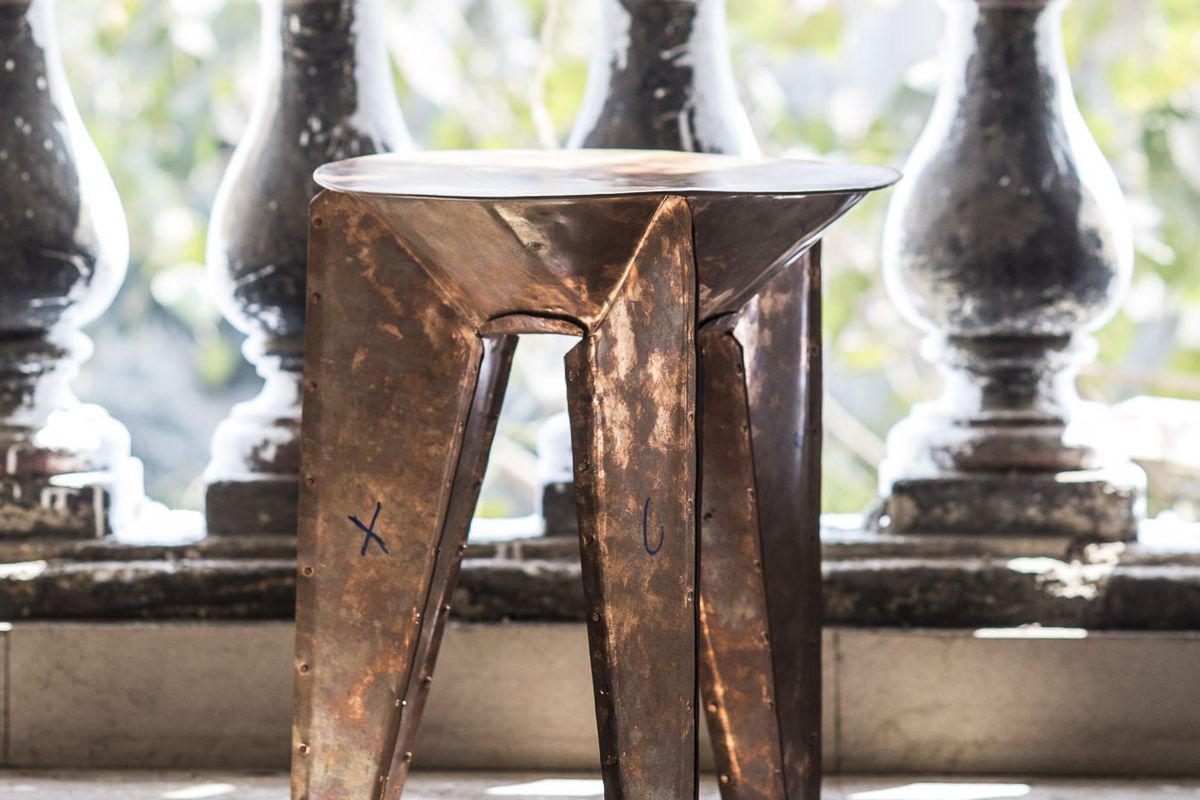
Trent Jansen
Jugaad With …
I am interested in the Australian philosophy of make do - to do your best with what you have. Jugaad is the Indian make do, with a slight twist. Jugaad is doing just enough with what you have, and it is also figuring it out as you go ~ improvising, rather than planning the direction forward. You can see this philosophy in action everywhere in India: From the way that people cross the street ~ stepping off the footpath and meandering through the traffic in whichever direction provides a free path; to high-rise construction ~ steel reinforcement protrudes from half built skyscrapers all over this country. It seems that these projects will be finished when there is the time and/or money to do so.
The objects produced in this way for Porosity Kabari are of little significance in and of themselves. There are so many materials, processes and possible design directions that could have been explored here that the artefacts we have made are a small sample of what might have been. These objects are not carefully thought out, meticulously planned or painstakingly crafted, they are not the self-conscious innovations of designers presenting their most treasured ideas to a critical audience. The outcomes that we reach are completely dependant on the alleyway we chose to venture down, and the material or maker that just happened to be at the end of that street.
Each object in this collection is an experiment with jugaad, with every improvised decision sending that project in a new direction. The destiny of each object was guided by a series of instantaneous and unplanned decisions, who knew where they would end up. These objects are the physical embodiment of jugaad ~ figured out as we went.
Image: Trent Jansen, Jugaad with car parts, 2016. Photo: Neville Sukhia
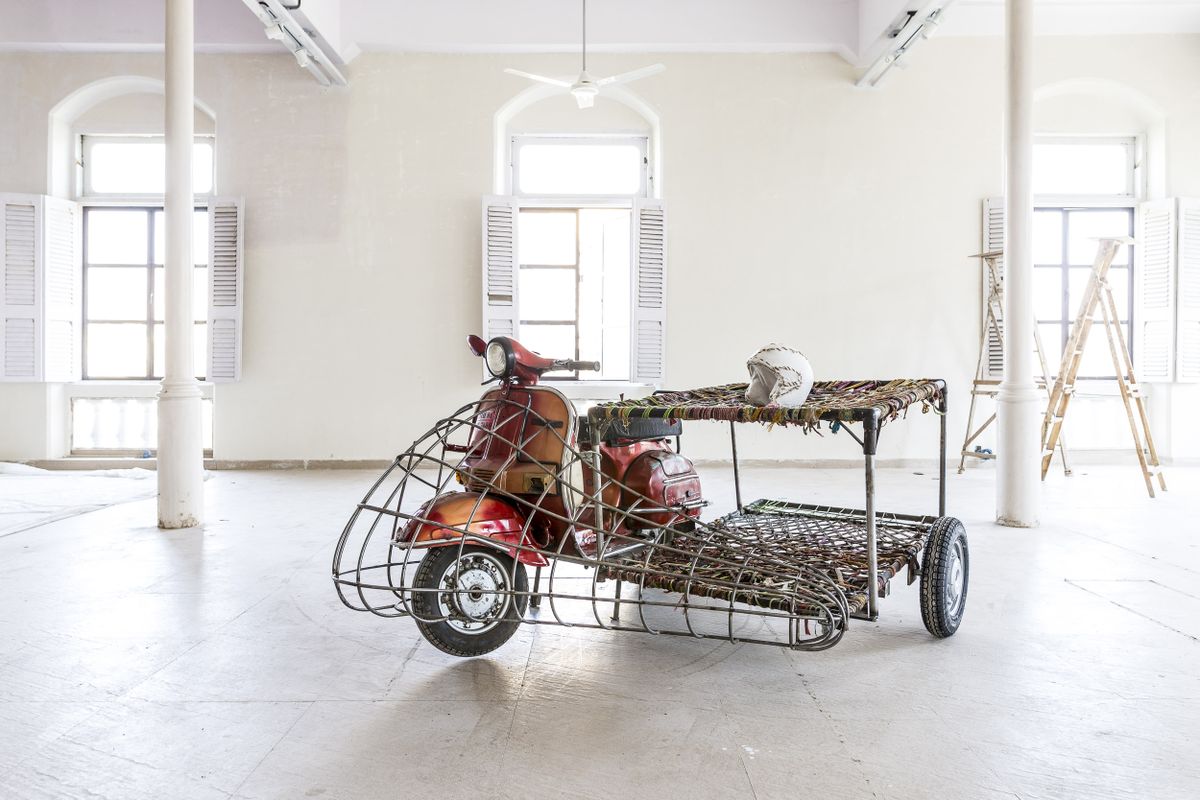
Richard Goodwin
1-√2 charpai for mumbai 2016
This artwork installation continues my inquiry into where the body ends and architecture begins. By embracing the concept, that the human condition is “insect-like”, and subject to our changing “exoskeletons”, 1-√2 charpai for mumbai focuses on the combination of the classic motor scooter and the Indian charpai bed.
The charpai exists in the street as much as the scooter does – one object remains static, while the other is primarily kinetic. It can be argued that the relationship between architecture and the car is a dumb one. Equally it can be argued that the architecture of roads flows awkwardly between buildings and architects can rarely have power over their footprints. The future of cities can bring these elements together. The poor social construction of isolated cars on roads needs to be rethought – allowing for the car to come home and marry its architecture with that of the building.
The slum has lessons for 21st century architecture. With their highly developed social constructions, the problems within slums can be continually addressed as people struggle within abject conditions and inadequate amenity to find solutions. The slum is an engine of ideas. As I observe and learn from the street, I see images of synthesis between the charpai and scooter form. This art installation combines an “asymmetrical” vehicle, which desires to come home and be part of the home, to also be nomadic. Its asymmetry forms a sign of desiring completion. It is a high-rise bedroom on the move. The vehicle enables three bodies, in social communion, and blurring the gap between body and architecture, to roam the streets for completion.
Image: Richard Goodwin, 1-√2 charpai for mumbai, 2016. Photo: Neville Sukhia
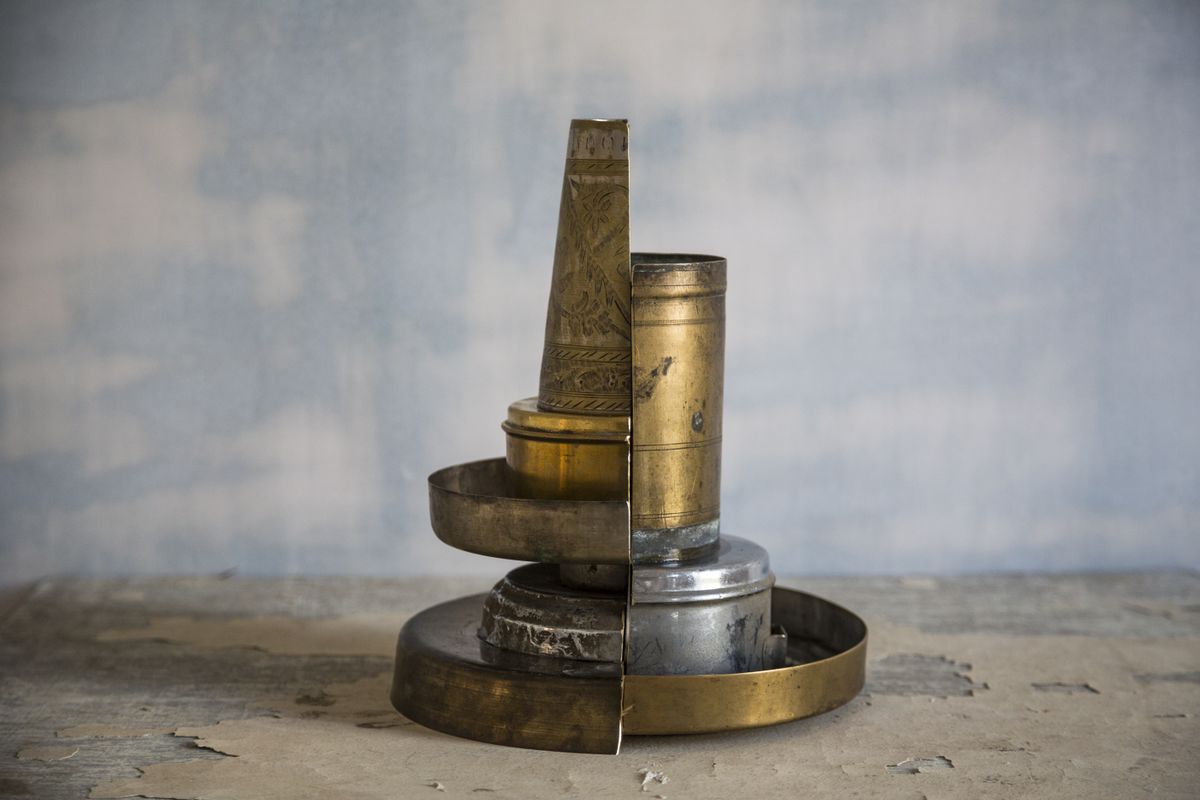
Ishan Khosla
The Paritition of the Mind,
Material: Brass mixed with other alloys
I have taken traditional everyday objects associated with domesticity, food, livelihood, which represent social structures —and cut them in half as a metaphor of the rift occurring in India today. Made from the very objects that were used in traditional Indian homes — the brass thali (plate), lassi glasses, tiffins, etc, have been transformed into a new idiom. These objects have been used here as metaphor of the division of our home and society— in a country that is obsessed with “progress” and the GDP — at the stake of our traditional values and an ideals of egalitarian ness. In the past, when joint families existed, there were safety nets in place, which meant a family member in need would get support from other members of the family. Similarly kings would keep some money from tributes given to them aside in times of need, such as famines to help support his subjects in the hour of need.
This fracture of values, traditions and empathy for each other, has led to an endless cycle of consumerism and desire in globalized India and the increase in the divide between the people with plenty and the people with nothing.The farmer suicides prevalent across India today, are a stark reminder of how we Indians are partitioning ourselves for self-gain and greed. We have forgotten that we are a part of a larger joint-family of India.
In this artwork, whose materials have been sourced from Chor Bazaar, I have used the the idea of a fissure in our social structures as a metaphor for the creation of a new structure. This new structure has been created out of the bedrock of our traditions (the utencils), albeit in a very haphazard and unrecognisable manner with scant regard and sensitivity to our culture and values — all in the rush for progress and industrialisation. We can still recognise that the new structure has been made from the old, but its hard understand how this structure, which has a very different purpose has come about.
Image: Ishan Khosla, Partition of the mind, 2016. Photo: Neville Sukhia
